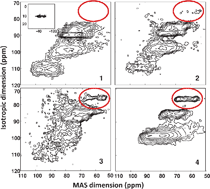New insights into oxygen environments generated during phosphate glass alteration: a combined 17O MAS and MQMAS NMR and first principles calculations study
Abstract
In the present study, we used a combination of

Maintenance work is planned for Wednesday 1st May 2024 from 9:00am to 11:00am (BST).
During this time, the performance of our website may be affected - searches may run slowly and some pages may be temporarily unavailable. If this happens, please try refreshing your web browser or try waiting two to three minutes before trying again.
We apologise for any inconvenience this might cause and thank you for your patience.
* Corresponding authors
a
UCCS-Unité de Catalyse et Chimie du Solide, UMR CNRS 8181, École Nationale Supérieure de Chimie de Lille, Université des Sciences et Technologies de Lille, BP 108, 59652 Villeneuve d'Ascq Cedex, France
E-mail:
laurent.delevoye@ensc-lille.fr
b CEA, IRAMIS, Service de Chimie Moléculaire, LSDRM, F-91191 Gif-sur-Yvette, France
c Institut de Minéralogie et Physique des Milieux Condensés, Université Pierre et Marie Curie, Campus Boucicaut, 140 rue de Lourmel, 75015 Paris, France
In the present study, we used a combination of

 Please wait while we load your content...
Something went wrong. Try again?
Please wait while we load your content...
Something went wrong. Try again?
N. Forler, F. Vasconcelos, S. Cristol, J. Paul, L. Montagne, T. Charpentier, F. Mauri and L. Delevoye, Phys. Chem. Chem. Phys., 2010, 12, 9053 DOI: 10.1039/C003550E
To request permission to reproduce material from this article, please go to the Copyright Clearance Center request page.
If you are an author contributing to an RSC publication, you do not need to request permission provided correct acknowledgement is given.
If you are the author of this article, you do not need to request permission to reproduce figures and diagrams provided correct acknowledgement is given. If you want to reproduce the whole article in a third-party publication (excluding your thesis/dissertation for which permission is not required) please go to the Copyright Clearance Center request page.
Read more about how to correctly acknowledge RSC content.
 Fetching data from CrossRef.
Fetching data from CrossRef.
This may take some time to load.
Loading related content
